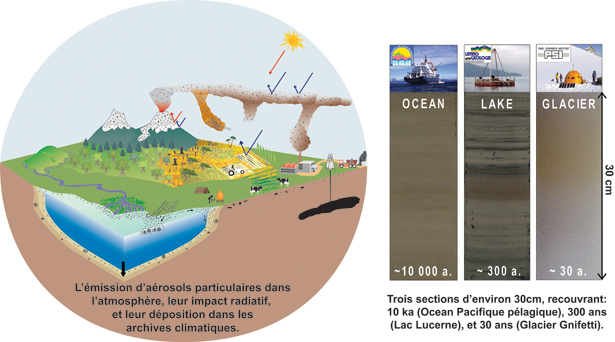Paleo-aerosols: Alpine climatic records
Paleo-aerosols: Natural and anthropogenic minerals aerosols from ice and sediment
Alpine records: Climatic, stratigraphic, and environmental implications.
Description :The original scientific approach in the frame of this project will address the issues of:
- The calibration of the data measured from different climatic archives (sediment and ice cores).
- The cross-fertilization of new environmental markers providing precise tools for dating those archives.
- The physical and chemical characterization of the airborne minerals that were transported to Europe, in regards to past atmospheric circulation changes and anthropogenic human disturbances.
This research project aims to analyze an Alpine ice core (Glacier Colle Gnifetti, 4555 m) and two lacustrine sediment cores (Lake Lucerne, 434 m; and Lake Schwaerze, 2780 m) with the same analytical methods. The reconstruction of the natural (aeolian dust) mineral aerosols emissions will provide valuable data for reconstructing the atmospheric (climatic) changes that occurred in Central Europe over the last two millennia on seasonal to decadal time scale. In fact, the transport of mineral aerosols toward the Alps is primarily influenced by (i) a deficit of precipitation over North Africa in winter, and by (ii) the dynamic of the southwesterly dust laden winds from the Sahara, i.e., by the large-scale atmospheric circulation through the North Atlantic Oscillation (NAO)-like variability. The characterization of the airborne minerals entrapped in European climatic archives therefore offers a unique possibility for:
- Reconstructing past atmospheric circulation changes.
- Understanding the recent increase in the continental dust flux recorded at high altitude in the Alps.
- Estimating the proportion of the fossil fuel combustion material in the total mineral aerosol emissions.
- Apprehending the preindustrial radiative forcing by natural and anthropogenic aerosols.
Framework/Financing:Ambizione project financed by the Swiss National Science Foundation (SNSF) for 3 years (2008-2011).
Collaborations : Institut Forel, UNIGE, UNIL, EAWAG, EMPA, Météo Suisse, ETHZ, PSI.
Supervisor : Dr Florian Thevenon
